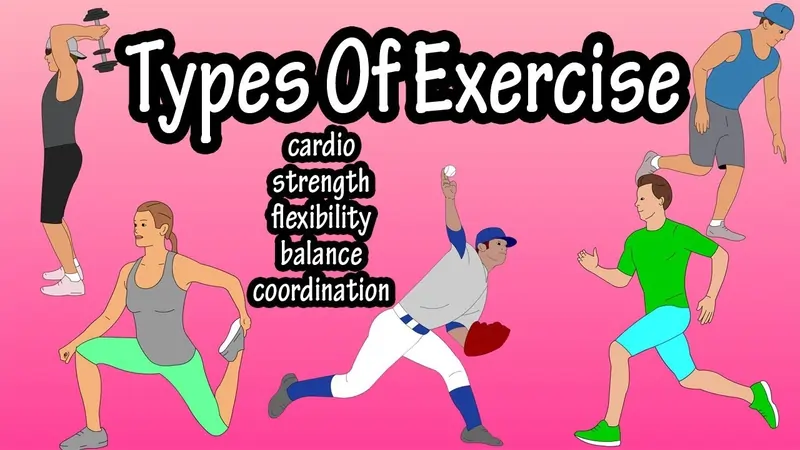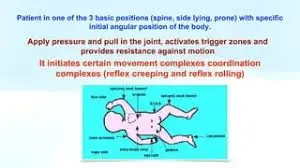Find Your Perfect Fit: Different Types of Exercise Explained
Exercise is defined as a type of motion that is intentional, structured, and regular. There are many types of exercise to do, In this article, we explain different types of exercise and their benefits and how to add them to your daily routine.
The health advantages of exercise are broad and include enhancing mental, cardiovascular, and structural well-being. Analysis has also shown that regular exercise guards against many chronic diseases, extreme weight gain, and obesity. Engaging in routine exercise is arguably one of the best approaches to enhance your health and improve longevity.
Physical activity is one of the most useful methods to help control cardiovascular (CV) disease and boost CV health. Exercise programs that are classified as either aerobic or anaerobic vary in terms of the muscle fiber types, intensity, and intervals they involve.
Introduction
Exercise is a part of physical activity. Training stands apart from other forms of exercise because it is a planned, structured activity designed to enhance and maintain physical fitness. The development of physical fitness through the body’s and its systems’ adaptation to an exercise program is referred to as physical activity.
The terms Physical activity and movement are usually used interchangeably, but this article will differentiate between them. All energy expenditure resulting from skeletal muscle movement is included within the broad definition of physical activity, which covers the entire range of activity from very low resting levels to maximal exertion.
Principles of exercise training
Research in exercise activity has guided the recognition of several general principles of conditioning. A successful training program must be developed using these guidelines.
Specificity
The observation that the body adapts differently depending on the type of training it receives or changes in physical fitness accounts for the specificity. That suggests that flexibility training is required if one’s goal is to become more flexible. Strengthening or resistance exercises are necessary if one wants to gain strength. this is a straightforward principle, but it gets overlooked a lot.
Overload
The second key concept is overload, which states that an individual must continuously raise the demands made on the relevant body systems to improve any aspect of physical fitness. For instance, lifting progressively heavier objects is necessary to develop strength. Expanding the distance or speed at which one runs can cause overload in programs.
Progression
A common mistake made by people is to attempt a fitness change too quickly. A common example is the middle-aged individual who hasn’t worked out in 20 years and then starts an intense training regimen. Often, this kind of exercise results in an injury or at the very least, soreness and stiffness. On how quickly to advance to a higher level of activity, there are no hard-and-fast guidelines.
As a good guide, one’s subjective assessment of how well their body appears to handle increased training is useful. It might generally make sense to limit your progress to higher activity levels to no more than once every one to two weeks.
Warm-up/cool-down
Starting an exercise session slowly and ending it gradually are two more important guidelines to follow when following an exercise program. The warm-up enables different body systems to adapt to higher metabolic needs. Muscle temperatures rise, blood flow increases and heart rate increases. Starting an exercise session with a warm-up is safer and undoubtedly more comfortable.
One effective method of warming up is to gradually increase the intensity of your workouts or walk faster. Cooling down, or progressively lowering the intensity of your workout, after each session is equally important. Reduce exercise intensity gradually—after each session.
A sudden stop to intense exercise can result in blood clotting in the legs, which can lead to fainting or, more dangerously, occasionally worsen cardiac problems. It is therefore a good idea to finish an exercise session with five minutes of slow walking and stretching. During the cool-down, the heart rate should gradually decrease until, after five minutes, it should be less than 120 beats per minute for people under 50 and less than 100 beats per minute for people over 50.
Frequency, intensity, and duration
Exercise physiologists have created formulas based on research to recommend an individual’s daily exercise dosage. Everyone agrees that regular exercise is necessary to improve and maintain physical fitness. Three days a week or roughly every other day seems to be the minimum sufficient frequency. Many people exercise more frequently than this, and it is certainly acceptable to exercise more frequently as long as one avoids becoming overly tired and getting sick or hurt.
A great deal of research has been done on the level of exercise intensity necessary for achieving benefits. A common belief is that physical activity is useless unless it causes pain. It’s just not true. Frequent exercise at 45–50% of one’s maximum capacity is sufficient to enhance general health and physiological performance. Most people find this level of intensity to be comfortable. Monitoring heart rate while exercising is a dependable method of determining exercise intensity.
A person’s maximal capacity is roughly 50% of his exercise heart rate, which is equivalent to 65% of his maximal heart rate. One can calculate their maximum heart rate by deducting their age in years from 220 (or, for males who are actively engaged, by deducting half of their age from 205). Therefore, the estimated maximum heart rate of a 40-year-old man who is sedentary is 180 beats per minute. This person is exercising at 117 beats per minute, which is approximately 50% of his maximal capacity, as this is 65 percent of his maximal rate. A person should exercise for several minutes to allow their heart rate to adjust to determine their exercise heart rate.
After that, the exerciser should pause, rapidly check their pulse, and count the beats for fifteen seconds. You can calculate the rate in beats per minute by multiplying this by 4. Since the heart rate quickly returns to resting levels after exercise is stopped, it is imperative to take the pulse right away. As was already mentioned, exercising at a 50% intensity will enhance physiologic functioning and have positive health effects. The maximal level of fitness required for competitive athletics will not be attained with this level of exercise.
Overall conditioning
The previous discussion of aerobic fitness has received a lot of attention because it is a crucial type of conditioning. However, it should be mentioned that there are advantages to other forms of conditioning as well. To maintain body mass and appropriate strength levels for daily functioning, a comprehensive exercise program should include strengthening exercises. Stretching exercises should be included to maintain joint mobility and flexibility.
According to the above-discussed specificity principle, no single exercise is likely to have the overall conditioning effect. Aerobics exercises that build the strength and endurance of different skeletal muscle groups, and flexibility exercises to preserve healthy joint function should all be included in an exercise program.
Individual differences
The above-discussed exercise training principles should be seen as broad recommendations. Exercise-related physiological and psychological adaptations vary amongst individuals. When two people who are very similar to each other begin the same exercise program, their perceptions of it might be completely different.
The exercise may seem excessively easy to one person while being far too difficult to another. It is appropriate to make adjustments to the exercise plan to accommodate personal preferences. Similarly, some people will advance to higher-intensity training levels far faster than others. As previously stated, exercise progress should be modified based on the exerciser’s evaluation.
People also vary in what kinds of exercises they enjoy or can handle. For example, not everyone is a jogger. Many people who find jogging uncomfortable or who sustain injuries from running can find other forms of exercise that are just as fulfilling, like walking, cycling, swimming, or playing sports. Numerous forms of physical activity are suitable and can benefit an individual’s physiology and well-being. The ideal workout varies widely. It’s crucial to exercise consistently and adhere to the broad recommendations provided in this section.
Physiological effects of exercise
Neuromuscular effects
Strength and endurance: Skeletal muscle strength and endurance are increased with appropriate exercise. More muscle mass is linked to increases in muscular strength, and better blood flow to the working muscles is linked to increases in muscular endurance.
Resistance training is the method used to get these outcomes. A suitable stimulus for strength training is any exercise that makes the muscle tense up more, regardless of whether the muscle shortens during contraction. One can apply resistance to a muscle group by trying to move an immovable object, working for one muscle group against another, lifting weights, or using specialized machines and devices for strength training.
Strength-training equipment comes in a variety of forms and, with the right use, can improve muscle strength and endurance. Some of the equipment may develop maximal performance more effectively, which is crucial for competitive athletes. However, for the average person training to sustain a respectable level of muscle fitness, any program or device is likely to be about as effective as another.
Exercises for strength and endurance are performed by completing multiple sets, or “reps,” of a particular exercise before switching to a different exercise that targets a different muscle group. Experts typically advise choosing a resistance that is about 65% of the maximum weight that an individual can lift for that specific exercise. Twelve repetitions of that exercise should be possible with this load in twenty to thirty seconds.
Two or three sets of a particular exercise are advised for every training session. A set consists of eight to twelve repetitions. Two to three days a week should be dedicated to strength and endurance training for the average person. Running or other aerobic exercises are performed in between sets of super-circuit weight training, which is a program that improves strength and aerobic capacity.
Flexibility: Stretching tendons and muscles can increase flexibility or a joint’s range of motion. A few basic principles are followed in flexibility training. Stretching the muscles and other connective tissue surrounding a joint is necessary to increase its range of motion. The recommended method of stretching is to gradually extend the range of motion. Muscles should stretch during exercise, but not to the point of pain. Stretching should be done slowly, and after the body has been stretched for ten to twenty seconds, it should be gradually returned to a relaxed posture.
The individual will maintain good flexibility by performing this kind of stretching on each muscle group as part of the strengthening and conditioning program. It is best to stay away from bouncing or sudden stretching exercises since they can cause tears in the muscles or tendons.
Cardiorespiratory effects
Cardiac effects: The heart muscle is directly impacted by regular aerobic exercise training. With exercise training, the left ventricle’s muscle mass—the pumping chamber that distributes blood throughout the body—increases. As a result of this modification, the heart can pump more blood with each beat. The heart essentially becomes a larger, stronger, and more effective pump that can accomplish more work with less effort.
Circulatory effects: Circulation changes are another effect of regular exercise. Muscle endurance training, as previously mentioned, helps to improve blood flow to the working muscles. The muscle cells can receive more oxygen and fuel thanks to the increased blood flow. Blood volume and red blood cell count, which transport oxygen in the blood, both rise with exercise. When combined, these modifications show that the working muscles have a higher ability to receive oxygen.
Pulmonary effects
Facilitating the passage of carbon dioxide from the blood into the atmosphere and oxygen from the atmosphere into the blood is the primary role of the lungs. Air must enter and exit the lungs, and respiratory gases must diffuse from the lungs into the bloodstream and vice versa to achieve this.
Exercise has been demonstrated to not affect this diffusing ability, but it does strengthen the breathing muscles. Forced vital capacity—the maximum amount of air that can be exhaled following a full inspiration may also rise in a trained person as a result of being able to transfer more additional air through the lungs per period unit.
Health effects of exercise
Improved general fitness
An increase in general fitness is the biggest advantage of regular physical activity. As was previously mentioned, the right kind of exercise enhances flexibility, body composition, muscular strength and endurance, and cardiorespiratory endurance. Most people don’t place much emphasis on their maximal oxygen intake or cardiorespiratory endurance on their own.
The key point is that peak performance levels have a strong connection to an individual’s capacity for sustained energy expenditure. Take, for instance, the straightforward task of walking three miles per hour. About three times the resting metabolic rate of energy is required to complete this task. The maximum aerobic power of an extremely unfit person may only be six times their resting metabolic rate.
For those people, walking three miles per hour takes half of their maximum energy. The same walk will only account for 25–30% of a middle-aged person’s maximal aerobic power because they will have a maximal aerobic power 10–12 times when they are resting. This example shows how the conditioned individual finds any submaximal task to be comparatively much easier. Furthermore, an individual can’t work at a level higher than roughly 20% of their maximum capacity throughout the day without developing chronic fatigue.
A deconditioned individual with a maximum aerobic power of six times resting can easily work at a level only roughly 1.2 times resting all day (6 × 0.20 = 1.2). This limited capacity for prolonged energy expenditure can only sustain an extremely sedentary lifestyle, such as 20 hours per day of rest and sleep, 2 hours of personal care, 1 hour of housework and shopping, and 1 hour of activity at a rate three times that of rest.
The previous discussion’s main takeaway is that one can calculate their average daily energy expenditure requirement and that an individual’s maximum cardiorespiratory endurance limits how active they can be. People who try to live lives that are more active than their current level of fitness will eventually tire out easily. Conversely, those who are at an optimal or adequate level of fitness find it easier to meet the physical demands of an active lifestyle. One of the most common comments made by people who start an exercise program is that they feel better; studies show that people who are more active report feeling better overall.
Decreased risk of coronary heart disease
In the developed world, coronary heart disease is the primary cause of death. Myocardial infarction, also known as a heart attack; angina pectoris, or chest pain; or unexpected cardiac arrest-related death or irregular cardiac electrical activity are all considered symptoms of coronary heart disease.
Atherosclerosis, a disorder marked by the buildup of cholesterol and the proliferation of smooth muscle cells in the artery lining, is the fundamental disease process that causes coronary heart disease. As a result, the arterial channel gradually narrows, lessens, and may eventually cease to allow blood to pass through an artery. One of the signs of coronary heart disease happens when this happens in a coronary artery, which is an artery that supplies the heart.
Epidemiological evidence of exercise benefits
Sedentary lifestyles are associated with high rates of death from coronary heart disease, according to studies. According to one study, dockers in San Francisco who held jobs requiring high energy expenditure had a lower risk of passing away from heart disease than those who held sedentary positions.
This study revealed that sedentary workers were roughly twice as likely to die from heart disease over a 22-year observation period and that dockworkers and cargo handlers burned at least 1,000 kilocalories more per day than clerks and foremen. Neither the shift in less healthy men to sedentary jobs nor other coronary heart disease risk factors like obesity, smoking, or high blood pressure contributed to the higher death risk among the less active men.
About 17,000 male Harvard University graduates were the subject of a long-term health study. While the jobs these men held were all essentially sedentary, they varied in how much of their spare time they spent exercising. Just half as many men died from heart disease as those who engaged in physical activity for at least 2,000 kcal per week, compared to those who engaged in less than 500 kcal per week. Some of this energy was used up by regular activities like climbing stairs rather than exclusively in fitness regimens.
Exercise’s impact on coronary heart disease risk factors
The development of the risk factor theory of coronary heart disease is one of the major medical accomplishments of the 20th century. Researchers have found that the risk of dying from coronary heart disease is significantly higher in people who are overweight, smoke, have high blood pressure, or have elevated blood levels of specific molecules that carry fat and cholesterol. Moreover, the risk of dying increases exponentially when these risk factors are combined.
Understanding the atherosclerotic process and its prevention and treatment has resulted from the identification and characterization of risk factors. There is evidence that regular exercise can reduce a person’s exposure to multiple risk factors.
The blood carries complex molecules known as lipoproteins that carry fat and cholesterol. Students have recognized multiple categories of lipoproteins and have clarified their functions in the advancement of atherosclerosis. Therefore, lipoprotein profiles that are abnormal or high-risk can be described.
A person’s lipoprotein profile is mostly determined by their diet and genetics, although exercise also has a significant impact. For most people, regular aerobic exercise improves their lipoprotein profile. The amount of exercise required to cause a positive change in the lipoprotein profile appears to be eight to ten miles of running (or its equivalent in other activities) per week, though further research is required to fully comprehend this association.
Hypertension, or elevated blood pressure, is another potent risk factor for coronary heart disease. The risk of developing hypertension is increased by sedentary lifestyle choices and low levels of physical fitness. In at least some cases of hypertension, exercise also seems to reduce blood pressure. Younger individuals (those under 40 to 45 years old) with relatively recent onset hypertension are likely to benefit the most.
Most experts believe that being overweight is a stand-alone risk factor for coronary heart disease, but obesity also raises the risk indirectly by negatively affecting blood pressure and lipoprotein profile.
Body weight and exercise habits are highly correlated. Individuals who engage in more physical activity tend to weigh less in almost all large population studies. Loss of body weight and fat is one of the most reliable outcomes of exercise-training studies. Exercise and diet plans are more effective in helping people lose weight than those that only focus on diet.
Other beneficial health impacts
Research points to the possibility that regular exercise can aid in the management or avoidance of other chronic illnesses. Frequent exercise, for example, helps control type 2 diabetes. With this type of diabetes, which is a serious health issue, the patient has elevated blood sugar even though their insulin levels are within normal range. Insulin is a hormone that normally helps the body use excess sugar by allowing it to be absorbed by the cells. Insulin injections are not necessary for blood sugar control in patients with this illness.
Though their effectiveness has been questioned, there are oral medications that lower blood sugar levels. Because they both lower blood sugar, exercise, and dietary changes have emerged as the most important strategies for managing type 2 diabetes. Blood sugar can be absorbed and used as fuel more easily when cells are more insulin-sensitive, which appears to be achieved through exercise.
A lower risk of acquiring some cancers, including endometrial, colon, and breast cancer, has been associated with increased physical activity. However, whether physical inactivity contributes to cancer is still unknown.
There are more health advantages linked to exercise. Aerobic exercise, for instance, has been shown to enhance cognitive function in middle-aged adults, elderly people, and young adults. Even short bursts of physical activity increase the formation of new synapses in the brain, according to studies conducted on mice. The junctions between neurons are called synapses, and learning and memory storage depend heavily on the formation of these structures. Exercise has also been demonstrated to enhance mood, increase vitality, and facilitate better sleep.
Health benefits of exercise
Multiple benefits of regular exercise have been studied in research, such as stronger bones and muscles, improved mood, and improved cardiometabolic health.
Improves cardiometabolic health
Frequent resistance training can help prevent and manage type 2 diabetes because it can help reduce visceral fat, which is fat that is stored in the abdomen close to important organs. Reductions in visceral fat also enhance insulin sensitivity and decrease HbA1c, a measure of blood sugar control.
By promoting the body’s natural oxygen delivery system, lowering inflammation, and widening blood vessels, aerobic exercise may enhance cardiovascular health. Moreover, exercise has been shown to lower blood pressure, triglycerides, low-density lipoprotein (LDL) cholesterol, and blood pressure—all of which are risk factors for cardiovascular disease.
Promotes bone and joint health
Aerobic exercise and resistance training preserve existing bone mass and stimulate bone growth. In older adults, weight-bearing exercise has also been demonstrated to preserve or enhance bone mineral density. Additionally, by reducing pain and enhancing joint function, regular exercise may benefit those who have osteoarthritis and other joint conditions.
Exercise involving weight bearing is particularly crucial for young children whose bones are still developing. Bone-strengthening exercises can include some aerobic and muscle-strengthening activities. Sports like tennis, hopscotch, running, and jumping rope are all examples because they apply force to the bones when they hit the ground. Bone growth and muscle strength are encouraged by this force.
Strength training is supposed to stunt a child’s growth and development has been debunked by numerous studies. The American Academy of Paediatrics states that strength training is safe for kids and teenagers who have mastered postural control and balance, which usually happens around age eight. It is advised that young people wait until they are physically mature to learn about safe practices, set limits on their resistance, and participate in bodybuilding and powerlifting.
Increases muscle mass and strength
As an adult, muscle mass gradually decreases. We call this sarcopenia. Adults who are sedentary are more likely to lose muscle mass more quickly—up to three to eight percent every ten years.
The good news is that you can start an exercise program at any time to maintain or gain muscle mass. At any age, strength training is a successful method for increasing muscle mass and strength. Resistance training is associated with improvements in muscle strength, gait speed, and overall physical performance in older adults, according to a systematic review of 58 randomized controlled trials. Longer lifespans are also linked to higher muscle mass. According to a study, adults who have higher levels of muscle mass also have a higher chance of living longer.
May boost mood
You can experience long-lasting benefits to your mental health by engaging in an exercise regimen. Anxiety and depressive symptoms were found to be lessened in three studies when participants engaged in aerobic exercise, such as jogging or cycling, for at least fifteen to thirty minutes a day. For both kids and adults, exercise also contributes to increased self-worth and confidence. Regular exercise can also strengthen your emotional toughness and enhance your stress-reduction abilities.
Aids in weight management
All forms of physical activity burn calories. Exercise is thus a popular method for managing and losing weight. Physical exercise can help people maintain their weight and lower their risk of excessive weight gain and obesity, according to a wealth of scientific research.
Walking in conjunction with a calorie-restricted diet was compared to a calorie-restricted diet alone in a randomized control trial involving eighty-two men and women. Over 12 weeks, the group that engaged in a walking regimen in addition to a calorie-restricted diet experienced greater weight loss than the group that solely followed the diet.
Gaining muscle mass through exercise increases your body’s capacity to burn calories and speeds up your metabolism.
Moreover, energy expenditure following intense aerobic exercise can be elevated for a few hours. In comparison to the rate of energy expenditure after a rest day, 45 minutes of intense cycling increased energy expenditure for 14 hours post-exercise in one study of young, healthy males. It has also been demonstrated that high-intensity interval training (HIIT), which consists of quick bursts of intense activity interspersed with short recovery intervals, raises metabolic rate for several hours after a workout.
Improves mobility and balance
Strengthening the neuromuscular control system—a network of muscles and neurons that regulates posture and movement—through stability training helps people become more balanced. Ankle and knee injuries in particular may be avoided by performing stability exercises regularly. Improved flexibility and range of motion are facilitated by stretching both before and after exercise.
What are the main types of exercise?
For optimum effect, the majority of experts advise combining different forms of exercise.
Aerobic exercise

Aerobic is defined as “requiring oxygen.” Your muscles receive the oxygen you breathe in during aerobic exercise, which gives them the energy they need to work. Exercise that involves the use of large muscle groups and can be sustained for a prolonged duration is commonly referred to as aerobic exercise. Aerobic exercise includes swimming, walking, jogging at a moderate pace, cycling, dancing, and hiking.
Exercise that increases heart rate and breathing is referred to as aerobic exercise, or simply “cardio.” Regardless of age or physical ability, everyone can gain from this kind of movement.
Blood pressure, cholesterol, and sleep quality can all be enhanced by aerobic exercise. These workouts have the potential to lower your long-term risk of numerous chronic illnesses, including type 2 diabetes and heart disease.
Depending on how much they speed up your heart rate and respiration, aerobic exercises can be classified as low, moderate, or vigorous. The talk test is one tool used to gauge the intensity of an activity. One way to gauge how hard you are exercising is to see if you can sing or talk while performing the exercise.
Low-intensity activities
You’re working out at a low intensity if you can sing and talk at the same time.
Low-intensity exercises are excellent for people of all ages and fitness levels, but they can be especially helpful for beginners, senior citizens, those with joint pain, and those recuperating from injuries. You can still get health benefits from these kinds of activities, and they might even help you maintain your physical activity goals.
Low-intensity activities include, for example:
- leisurely walking
- light swimming
- vacuuming, mopping, and other house-cleaning activities
- washing the car
- light gardening
Moderate intensity activities
Your heart rate increases with moderately intense exercise. You should be able to communicate during these exercises, but not sing.
Since many of the health benefits of aerobic exercise start in this range, most adults and children can benefit from moderate-intensity activities. A doctor should be consulted regarding the right intensity level for older adults or those with a medical history.
Among the moderately intense physical activities are:
- swimming or water aerobics
- jogging
- walking quickly
- dancing
- doing yard work
- leisurely biking

Vigorous intensity activities
You’re in the vigorous intensity range if you can barely speak a few words at a time and are out of breath.
Because it provides the same health benefits in a shorter amount of time, some people prefer this level of physical activity. But before engaging in any strenuous activity, you might want to see your doctor if you’re new to exercising or if you have any health issues.
Several instances of high-intensity exercises consist of:
- running or biking at a fast pace
- swimming laps
- playing basketball or tennis
- jumping rope
Although aerobic exercise has many health benefits, it’s crucial to begin at a level that works for you and progressively increases the intensity as your fitness level rises.
Anaerobic exercise
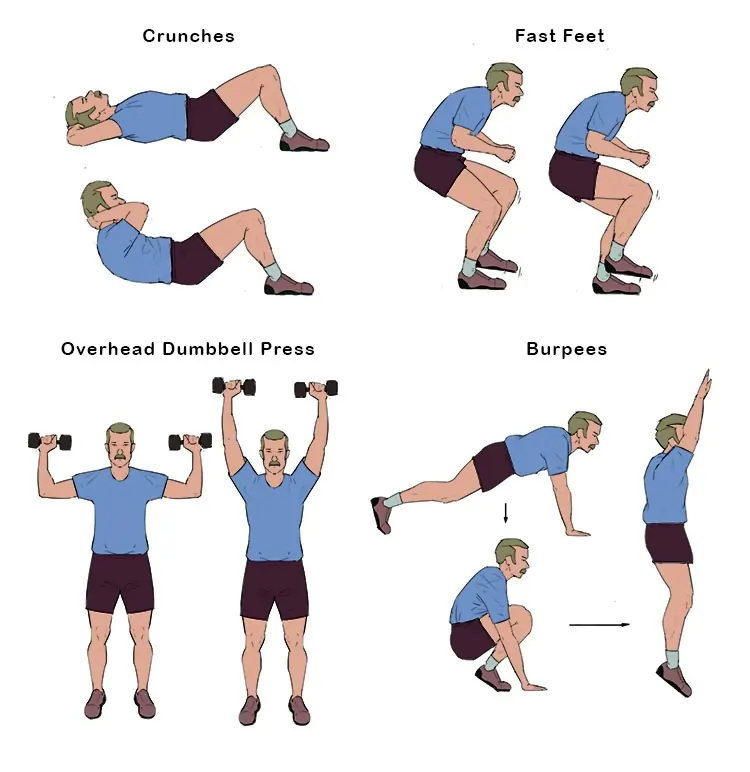
Exercises that involve brief, high-intensity bursts of physical activity are classified as anaerobic.
Because there is no increase in the absorption and transportation of oxygen during these exercises, they are anaerobic. In the absence of oxygen, the body breaks down glucose stores during anaerobic exercise, which causes lactic acid to accumulate in the muscles.
Examples of anaerobic exercises include:
- sprinting
- weightlifting
- high-intensity interval training (HIIT)
Anaerobic exercise is good for one’s cardiovascular health, just like aerobic exercise is.
Anaerobic exercise, on the other hand, uses up more energy from the body faster than aerobic exercise. Because of this, anaerobic exercise might be especially helpful for those trying to reduce their body fat.
Increased bone density and the ability to acquire or maintain muscle mass are further benefits of anaerobic exercise.
High-intensity and intervals (anaerobic)
We are now moving into the high-intensity region. You should put in a lot of effort at this point to raise and sustain your heart rate above 70% of your maximum heart rate. Sprints, which are some resistance training, and the type of high-intensity interval training that we at 8fit are famous for are examples of high-intensity workouts.
Exercises divided into multiple segments (repetition sets) and performed as a single exercise session are called intervals (i.e., a round). Though they can take many different forms, time or distance blocks are the most prevalent.
High-intensity workouts like sprints or skipping rope are considered working intervals, while lower-intensity activities like walking or a brief break are considered rest. Intervals are frequently divided into work-to-rest ratios. In terms of work-to-rest ratios, the following is a good general rule of thumb:
Beginner (1:2):
- To give the body time to recover, alternate between one high-intensity interval and two lower-intensity intervals before repeating the high-intensity interval.
Intermediate to the advanced athlete (2:1):
- In this case, half of the time is spent on recovery intervals and the other half is dedicated to high-intensity intervals.
One of the best things about these ratios is that you can experiment with the numbers to find the ideal ratio that will challenge you to the maximum.
Anaerobic workouts are often thought of as brief, high-intensity workouts.
Anaerobic exercise examples include:
- weightlifting
- sprinting
- HIiT
- exercises using only your body weight, like pushups and pullups
Different types of exercise include aerobic and aerobic workouts:
Resistance training
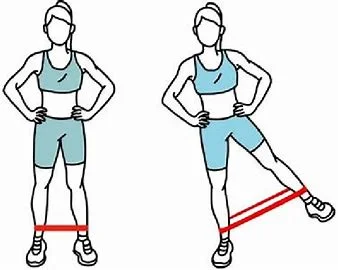
Anaerobic exercise, or physical activity that uses glucose (sugar) as energy without the need for oxygen, is what resistance training, also known as strength or weight training, is. Using body weight or external resistance, like free weights or weight machines, strength training seeks to increase and preserve muscle mass. The main muscle groups in the body, including the arms, shoulders, back, legs, glutes, chest, and abdomen, can be strengthened with resistance training.
Flexibility
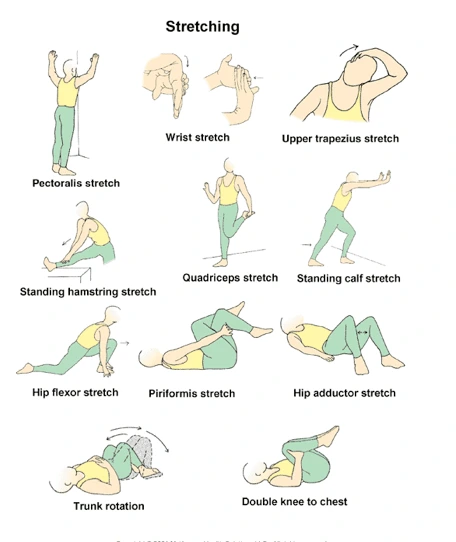
Your joint range of motion and muscle mobility are determined by your level of flexibility. It’s crucial to be flexible enough for everyday functioning, injury prevention, and athletic performance.
Stretching can be classified into two main categories: static and dynamic. A targeted muscle stretch is held for a while during static stretching. Active stretches that generally imitate an exercise that is about to be performed, on the other hand, are what define dynamic stretching. Flexibility is successfully increased and sports performance is enhanced by both forms of stretching. Stretching should be done either before or after a workout to better warm up the muscles. Static stretching is usually done after a workout when the muscles are more flexible.
As an exercise to improve flexibility, yoga is one of the most popular.
For the sake of your general health, include exercises that improve your flexibility. In addition to reducing pain in the body and increasing range of motion, these exercises can help avoid injuries.
Examples of flexibility exercises include:
- stretching
- yoga
- pilates
- tai chi
Before stretching, make sure to move your muscles for five to ten minutes to warm them up. Your muscles receive more blood and oxygen as a result, which makes it easier for them to stretch.
Additionally, you could perform your flexibility exercises as part of your cool-down or following another physical activity. Recall that stretching shouldn’t cause pain. Just stretch your muscles as far as feel comfortable to prevent injury.
Stability and balance exercises
The core muscles in your body, which include those in your back, pelvis, and abdomen, are worked and strengthened during stability and balance exercises. These movements are typically slow and controlled. All age groups can gain from using these muscle groups in stability exercises, which can also enhance a person’s capacity to perform daily tasks like getting out of a chair, climbing stairs, and lifting heavy objects. There are times when this kind of fitness is called functional fitness.

Poor posture, instability, and decreased athletic performance can result from weak core muscles. Exercises that work multiple muscle groups should be a regular part of your routine to strengthen your core muscles and enhance your stability. Planks, push-ups, and glute bridges are a few examples. Another well-liked workout for enhancing core strength and stability is Pilates. Stability and balance can also be enhanced by engaging in exercises that test your balance, like walking backward or standing on one leg.
Good balance is essential for daily tasks like walking and stair climbing and can help older adults avoid falls and injuries.
Among the balancing exercises are:
- walking heel to toe
- balancing on one foot and then moving to the other
- yoga
- tai chi
- standing up from a seated position
Strengthening exercises
Exercises that strengthen your muscles should be a part of your workout routine in addition to aerobic ones.
These physical activities play a crucial role in maintaining bone and muscle mass as one ages healthily. Given that bone and muscle loss are common during and after menopause, women in particular can benefit from strengthening exercises.
Exercises for building strength can be performed at home, in a gym, or without any equipment. Choose an exercise regimen that fits your needs and way of life from the many options available to you to strengthen your muscles. Here are a few examples:
- lifting weights
- working with resistance bands
- doing push-ups or sit-ups
- doing heavy yard work or gardening
- doing some forms of yoga
Just as with aerobic activities, make sure to start at a comfortable level and slowly increase the amount you do. Individuals who are older, pregnant, or have medical issues should talk to their doctor about the best strengthening exercises.

Pilates
This exercise program, developed by Joseph Pilates, combines controlled movements with a focus on alignment, breathing, and strengthening the core, which Pilates instructors refer to as the “Powerhouse.” Pilates will help you become more flexible over time while also enhancing your balance, coordination, and general stability.
How much exercise must I do?
The Department of Health and Human Services recommends adults participate in at least 150 minutes of moderate-intensity exercise per week. That represents about thirty minutes of exercise five times a week. For each age group, there are recommended physical activity guidelines.
Please be aware that each person’s recommendations may differ based on their health, circumstances in their life (such as pregnancy), and other factors.
How to begin an exercise regimen
Sometimes it’s difficult to get inspired to work out. Thinking about your motivation should be the first step. Perhaps your goals are to better control your weight, finish a 5K race, or have more energy throughout the day. Whatever it is, remember your “why” at all times.
Remember to set reasonable and doable objectives. To set goals for yourself, use the SMART criteria. The acronym outlines five guidelines that can be applied to set objectives and achieve desired results. These guidelines are as follows:
- Specific: what just do you want to gain?
- Measurable: How will you evaluate growth?
- Attainable: Is your objective attainable?
- Realistic: Is it possible to accomplish your goal with the resources you currently have?
- Time-related: When would you like to achieve your aim?
Utilize resources
You don’t necessarily need a gym membership to participate in these resources, which can assist you in reaching any kind of goal. There are lots of free online classes and fitness programs. Not to mention that you can engage in free outdoor activities like walking, running, and hiking.
When starting your exercise program, take into account these helpful resources:
- devices that track fitness
- Fitness centres and gyms
- Mobile applications
- Online training videos
- Support groups
Fitness classes and other resources to assist keep you on track with your plans are widely available online.
Safety considerations
When you engage in physical activity, think about the possible risks. It is recommended to gradually introduce new exercise routines to your body. If you want to lower your chance of bone, muscle, and joint injuries, avoid rapidly increasing your level of activity over a brief period. If you’re new to exercising, especially if you’re not too experienced, think about speaking with your integrative healthcare provider first.
Risks of exercise
The discussion above makes clear that engaging in a regular exercise program can have several advantages. However, there may be expenses involved with exercising, just like with other medical or health procedures. These expenses can include anything from little annoyances like the time spent exercising to more significant issues like accidents and even unexpected fatalities.
The exercise training will develop injuries to their bones, muscles, and joints, The most serious complication of an exercise program is sudden death. This is, fortunately, a rare occurrence. As was previously mentioned, some studies have demonstrated that people who regularly exercise have a lower chance of passing away from a heart attack.
Summary
Any movement you choose to do, including exercising during specified times and other everyday activities, is considered physical activity. Different physical activities can be done at different intensities, such as aerobic, strengthening, flexibility, and balancing exercises. Every variety has advantages for your health, so it’s a good idea to incorporate them all into your weekly regimen.
According to current guidelines, adults should aim for 150 minutes or more per week of moderate-to-intense aerobic exercise or 75 minutes or more of vigorous exercise. It’s crucial to start at a level appropriate for your mobility and fitness level and work your way up from there.
Eating the correct foods for your particular metabolism is a crucial step towards improving your general health: One of the best things you can do to enhance your health and lengthen your life is to exercise regularly. Regularly perform a combination of aerobic, strength, stability, and flexibility exercises for optimal outcomes.
FAQ
Which three forms of exercise are the most popular?
Aerobic, resistance, and strengthening exercises are the three primary categories of physical activity. Flexibility and balance exercises are also advantageous.
What are the physical effects of exercise?
Exercise can improve your cognitive function, help you maintain a healthy weight, strengthen your bones and muscles, reduce your risk of disease, and make it easier for you to perform daily tasks. Adults who reduce their sitting time and participate in moderate-to-intense physical activity can reap certain health benefits.
How frequently should someone work out?
Aim generally for moderate physical activity for at least half an hour each day. You might need to exercise more if you want to reach specific fitness goals, maintain weight loss, or lose weight. Reducing one’s amount of sitting time is also essential.
Why is exercise important?
Regular exercise can prevent heart disease, high blood pressure, type 2 diabetes, and weight gain. Exercises that strengthen bones, such as lifting weights, running, or jumping, can maintain strong bones. An individual can age well with exercise. Your body will thank you later, even though it might not seem important now.
How long should I exercise each day?
The ideal amount of exercise per week is between two and three hours, or 45 minutes to an hour and a half of moderate physical activity, and between twenty-four and forty-two minutes of vigorous physical activity.
References
- Ndtr, L. D. B. (2023, April 13). Types of exercise and their health benefits. Fullscript. https://fullscript.com/blog/exercises
- Vetter, C. (2024, March 19). Different types and examples of physical activity are explained. https://zoe.com/learn/physical-activity-examples
- Exercise | Definition, Types, Principles, & Health Effects. (2024, April 2). Encyclopedia Britannica. https://www.britannica.com/topic/exercise-physical-fitness/Other-beneficial-health-impacts
- c) Copyright skillsyouneed.com 2011-2024. (n.d.). Types of Exercise | SkillsYouNeed. https://www.skillsyouneed.com/ps/exercise-types.html
- Rettner, R. (2016, July 8). The 4 types of exercise you need to be healthy. livescience.com. https://www.livescience.com/55317-exercise-types.html
- 10 Best Exercises for Everyone – Baptist Health. (n.d.). Baptist Health. https://www.baptisthealth.com/blog/family-health/10-best-exercises-for-everyone
- Types of exercise. (n.d.). https://contenidos.bupasalud.com/en/health-and-wellness/bupa-life/types-exercise

